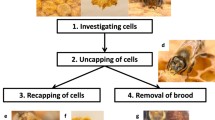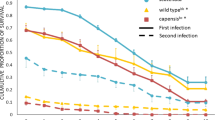Abstract
The short-sighted selection hypothesis for parasite virulence predicts that winners of within-host competition are poorer at transmission to new hosts. Social parasitism by self-replicating, female-producing workers occurs in the Cape honeybee Apis mellifera capensis, and colonies of other honeybee subspecies are susceptible hosts. We found high within-host virulence but low transmission rates in a clone of social parasitic A. m. capensis workers invading the neighbouring subspecies A. m. scutellata. In contrast, parasitic workers from the endemic range of A. m. capensis showed low within-host virulence but high transmission rates. This suggests a short-sighted selection scenario for the host–parasite co-evolution in the invasive range of the Cape honeybee, probably facilitated by beekeeping-assisted parasite transmission in apiaries.

Similar content being viewed by others
References
Allsopp M (1992) The Capensis calamity. South Afr Bee J 64:52–57
Allsopp M (1993) Summarized overview of the Capensis problem. South Afr Bee J 65:127–136
Allsopp M (1995) The Capensis problem 1992–1995. In: Magnuson P (ed) Proceedings of the First International Electronic Conference on the Cape Bee problem in South Africa 05–30 June 1995. PPRI, Pretoria, pp 10–31
Allsopp M, Crewe RM (1993) The Cape honeybee as a Trojan horse rather than the hordes of Jenghiz Khan. Am Bee J 133:121–123
Baudry E, Kryger P, Allsopp M, Koeniger N, Vautrin D, Mougel F, Cornuet J-M, Solignac M (2004) Whole-genome scan in thelytokous-laying workers of the Cape honeybee (A. m. capensis): Central fusion, reduced recombination rates and centromere mapping using half tetrad analysis. Genetics 167:243–252
Beekman M, Calis JNM, Boot WJ (2000) Parasitic honeybees get royal treatment. Nature 404:723
Bull JJ (1994) Perspective – Virulence. Evolution 48:1423–1437
Dietemann V, Pflugfelder J, Härtel S, Neumann P, Crewe RM (2006) Social parasitism by honeybee workers (Apis mellifera capensis Esch.): evidence for pheromonal resistance to host queen’s signals. Behav Ecol Sociobiol 60:785–793
Dietemann V, Neumann P, Härtel S, Pirk CWW, Crewe RM (2007) Pheromonal dominance and the selection of a socially parasitic honeybee worker lineage (Apis mellifera capensis Esch.). J Evol Biol 20:997–1007
Ebert D (1998) Experimental evolution of parasites. Science 282:1432–1436
Härtel S, Neumann P, Kryger P, von der Heide C, Moltzer G-J, Crewe RM, van Praagh JP, Moritz RFA (2006a) Infestation levels of Apis mellifera scutellata swarms by socially parasitic Cape honeybee workers (Apis mellifera capensis Esch.). Apidologie 37:462–470
Härtel S, Neumann P, Raassen FS, Moritz RFA, Hepburn HR (2006b) Social parasitism by Cape honeybee workers in colonies of their own subspecies (Apis mellifera capensis Esch.). Insectes Soc 53:183–193
Hillesheim E, Koeniger N, Moritz RFA (1989) Colony performance in honeybees (Apis mellifera capensis Esch.) depends on the proportion of subordinate and dominant workers. Behav Ecol Sociobiol 24:291–296
Kryger P (2001) The pseudo-clone of Apis mellifera capensis—an obligate social parasite in honeybees. In: Proceedings of the XXXVII International Apicultural Congress, Durban, South Africa, p 33
Lattorff HMG, Moritz RFA, Crewe RM, Solignac M (2007) Control of reproductive dominance by the thelytoky gene in honeybees. Biol Lett 3:292–295
Levin BR (1996) The evolution and maintenance of virulence in microparasites. Emerg Infect Dis 2:93–102
Levin BR, Bull JJ (1994) Short-sighted evolution and the virulence of pathogenic micro-organisms. Trends Microbiol 2:76–81
Martin SJ, Beekman M, Wossler TC, Ratnieks FLW (2002) Parasitic Cape honeybee workers, Apis mellifera capensis, evade policing. Nature 415:163–165
Moritz RFA (2002) Population dynamics of the Capebee phenomenon: the impact of parasitic laying worker clones in apiaries and natural populations. Apidologie 33:233–244
Moritz RFA, Haberl M (1994) Lack of meiotic recombination in thelytokous parthenogenesis of laying workers of Apis mellifera capensis (the Cape honeybee). Heredity 73:98–102
Moritz RFA, Kryger P, Allsopp MH (1996) Competition for royalty in bees. Nature 384:522
Moritz RFA, Kryger P, Allsopp MH (1999) Lack of worker policing in the Cape honeybee (Apis mellifera capensis). Behaviour 136:1079–1092
Neumann P, Hepburn HR (2002) Behavioural basis for social parasitism of Cape honeybees (Apis mellifera capensis Esch.). Apidologie 33:165–192
Neumann P, Moritz RFA (2002) The Cape honeybee phenomenon: the evolution of a social parasite in real time. Behav Ecol Sociobiol 52:271–281
Neumann P, Radloff SE, Moritz RFA, Hepburn HR, Reece SL (2001) Social parasitism by honeybee workers (Apis mellifera capensis Esch): host finding and resistance of hybrid host colonies. Behav Ecol 12:419–428
Neumann P, Radloff SE, Hepburn HR (2002) Parasitic Cape bees in the northern regions of South Africa: source of the founder population. S Afr J Sci 98:404–406
Neumann P, Pirk CWW, Hepburn HR, Moritz RFA (2003) Spatial differences in worker policing facilitate social parasitism by Cape honeybee workers (Apis mellifera capensis Esch.) in queenright host colonies. Insectes Soc 50:109–113
Onions GW (1912) South African “fertile-worker bees". S Afr Agric J 1:720–728
Pirk CWW, Neumann P, Ratnieks FLW (2003) Cape honeybees, Apis mellifera capensis, police worker-laid eggs despite the absence of relatedness benefits. Behav Ecol 14:347–352
Pirk CWW, Neumann P, Hepburn HR, Moritz RFA, Tautz J (2004) Egg viability and worker policing in honeybees. Proc Natl Acad Sci U S A 101:8649–8651
Pirk CWW, Neumann P, Hepburn HR (2007) Nestmate recognition for eggs in the honeybee (Apis mellifera L). Behav Ecol Sociobiol 61:1685–1693
Ratnieks FLW, Visscher PK (1989) Worker policing in the honey bee. Nature 342:796–797
Schmid-Hempel P (1998) Parasites in social insects. Princeton University Press, Princeton, NJ
Simon U, Moritz RFA, Crewe RM (2005) Reproductive dominance among honeybee workers in experimental groups of Apis mellifera capensis. Apidologie 36:413–419
Solignac M, Vautrin V, Loiseau A, Mougel F, Baudry E, Estoup A, Garnery L, Haberl M, Cornuet J-M (2003) Five hundred and fifty microsatellite markers for the study of the honeybee (Apis mellifera L) genome. Mol Ecol Notes 3:307–311
Spiewok S, Neumann P, Hepburn HR (2006) Preparation for disturbance-induced absconding of Cape honeybee colonies (Apis mellifera capensis Esch). Insectes Soc 53:27–31
Walsh PS, Metzger DA, Higuchi R (1991) Chelex 100 as a medium for simple extraction of DNA for PCR-based typing from forensic material. Biotechniques 10:506–512
Acknowledgements
We wish to thank Susanne Stüber and Petra Leibe for technical assistance and P Kryger for stimulating discussions. Financial support was granted by the European Union Commission Directorate General for Research sixth framework (STREP BEE SHOP [RFAM]) the Deutsche Forschungsgemeinschaft [PN, CWWP, RFAM] and the Deutscher Akademischer Austauschdienst [CWWP].
Author information
Authors and Affiliations
Corresponding author
Rights and permissions
About this article
Cite this article
Moritz, R.F.A., Pirk, C.W.W., Hepburn, H.R. et al. Short-sighted evolution of virulence in parasitic honeybee workers (Apis mellifera capensis Esch.). Naturwissenschaften 95, 507–513 (2008). https://doi.org/10.1007/s00114-008-0351-6
Received:
Revised:
Accepted:
Published:
Issue Date:
DOI: https://doi.org/10.1007/s00114-008-0351-6




